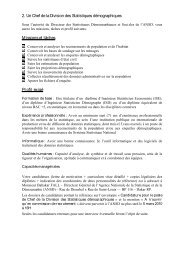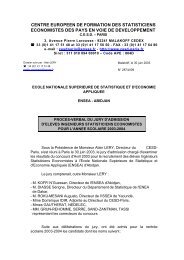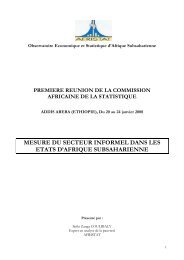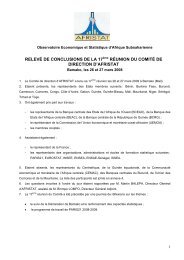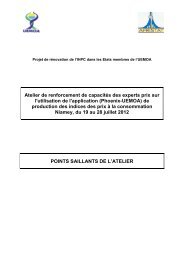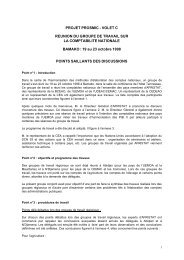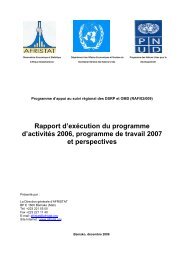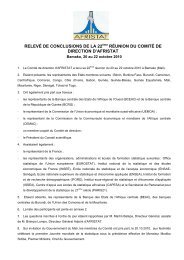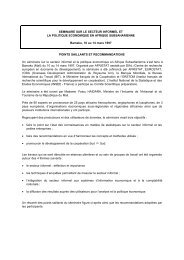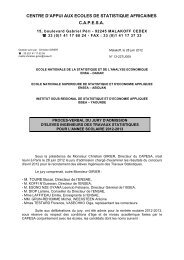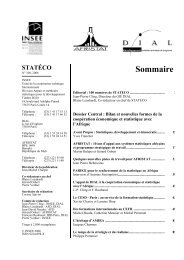Global Purchasing Power Parities and Real Expenditures - Afristat
Global Purchasing Power Parities and Real Expenditures - Afristat
Global Purchasing Power Parities and Real Expenditures - Afristat
You also want an ePaper? Increase the reach of your titles
YUMPU automatically turns print PDFs into web optimized ePapers that Google loves.
142 <strong>Global</strong> <strong>Purchasing</strong> <strong>Power</strong> <strong>Parities</strong> <strong>and</strong> <strong>Real</strong> <strong>Expenditures</strong>comparable economy from the same region was applied toproduction-based GDP aggregates to impute the basicheadingdetails. When necessary, the regional coordinatorassisted economies to produce the basic-heading estimatesby providing advice or by sending a statistician to workdirectly with the local national accountants. The regionalcoordinators <strong>and</strong> the global office reviewed the basic-headingbreakdowns for consistency across economies.Own-account production can be significant in developingeconomies, as can the activities of the informal economy.Economies that included own-account production intheir national accounts were asked to make adjustments totheir average prices at the basic-heading level to reflect itsimplicit price.A number of new items introduced in SNA93 (suchas mineral exploration, software, <strong>and</strong> valuables) were notincluded in some economies’ national accounts becausethey were still being compiled according to the Systemof National Accounts, 1968 (SNA68). To comply withICP requirements, those countries updated their nationalaccounts. Therefore, the GDP numbers for some countrieswill differ from those previously published by the WorldBank. (See appendix G for more details.) Given the difficultiesin collecting prices for most of these new items,“reference PPPs” (see page 144) were used instead of specificallycalculated PPPs (except for computer software, forwhich prices were specially collected).Price Data: Household ConsumptionExpenditure<strong>Purchasing</strong> power parities (PPPs) are derived from intercountrycomparisons of the national annual average pricesfor a representative selection of goods <strong>and</strong> services. Pricecomparisons are based on the principle of “matching likewith like.” Therefore, after determining which products toprice, it was necessary to carefully define their price-determiningcharacteristics so that comparable items were pricedacross all economies within each region.Because of the crucial importance of this part of thework, a new approach was adopted for the 2005 ICP. Thefirst step was to define “product clusters,” groups of productswith shared broad characteristics (for example, “freshwhole milk”), for which more-specific products neededto be specified. COICOP was used as the starting pointbecause most economies use it (or a compatible variant ofit) in compiling their national accounts or their CPI. Theproduct clusters were mapped to the Eurostat-OECD PPPclassification to identify products making up each ICP basicheading. Product characteristics were identified using theU.S. Bureau of Labor Statistics checklist from its consumerprice index as a starting point to develop a series of structuredproduct descriptions (SPDs), which define the keycharacteristics of each product to be priced (for example,type, variety, seasonal availability, quantity, packaging, <strong>and</strong>pricing basis). An SPD identifies those characteristics thatare price-determining. For example, the package type orweight of a product will often be price-determining, butthe color will not usually affect the price.Once an SPD was set up for the product cluster, individualproducts were identified by selecting the specific characteristicsof each product included in the pricing list. Eachselected product was given a detailed product specification.Each ICP region went through an independent exercise todefine the specifications of products to be priced.The number of products specified under a basic headingvaried from one basic heading to another (<strong>and</strong> evenfor the same basic heading in different regions) becauseof the number <strong>and</strong> diversity of price-determining characteristics.For example, given the centralization of postalservices in most economies, it was possible to cover verythoroughly the “postal services” basic heading with only ah<strong>and</strong>ful of products. On the other h<strong>and</strong>, the “bread” basicheading required a wide range of products to be specifiedbecause of the diversity of bread types available in differenteconomies.Developing the final product specifications was alengthy, iterative process. Chapter 5 of the ICP 2003–2006H<strong>and</strong>book describes in detail the preparation of the SPDs<strong>and</strong> the steps taken to derive product specifications withina region.A basic concept guiding the price collection is that theprices should be consistent with those underlying eacheconomy’s national accounts expenditure estimates. Theprices collected should include all nondeductible taxes, aswell as tips or gratuities (where significant). And the pricesrecorded must be annual national average prices consistentwith the values recorded in the national accounts. Meet-



